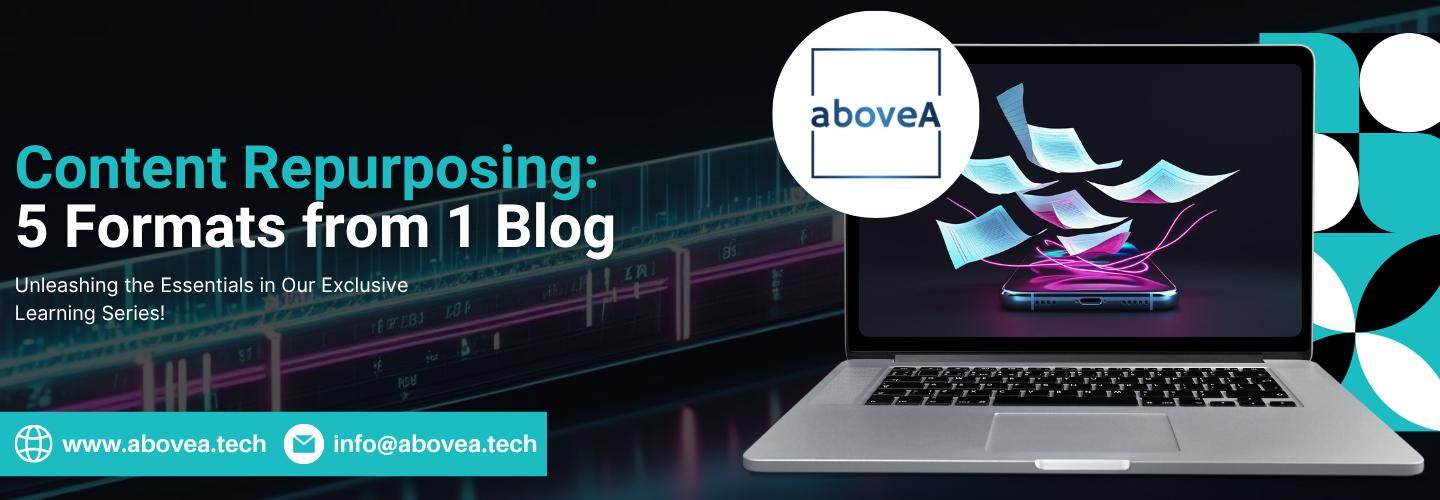
How to Repurpose Blog Posts for Content Marketing? (1 Blog Post to 5 Formats)
Repurposing Content can save your precious time because creating unique content takes time. Writing a blog post, formatting it, and promoting it can easily take hours, if not days. But what if you could stretch that effort further? That’s where content recycling can be helpful.
In this guide, we will explore how to repurpose one blog post into five different content formats. Without writing anything from scratch. You will learn how to turn your blog into videos, emails, social posts, and more.
Plus, we will cover what types of blog posts work best, which platforms to target, tools to make the process easier, and mistakes to avoid. If you want to grow faster with less effort, this is your roadmap.
Content Repurposing Strategy: Why It Works So Well
A smart content repurposing strategy can help you get more from every blog post you create. Instead of publishing once and moving on, you stretch that one piece across different channels and formats, saving time and expanding reach.
Also, repurposing will reduce content creation time. You already did the research, writing, and editing. Now, you can turn that blog into social posts, videos, newsletters, and even infographics – without starting over.
Repurposed content will also help you connect with different audiences. Some people love to read. Others prefer short videos or visual slides. Repurposing enables you to meet people where they are: on the platforms they already use. Finally, this approach will support your SEO and engagement goals. By doing this, you will build more internal links, drive return visits, and improve your brand’s overall content ecosystem. That’s why repurposing is not just smart; it’s essential.
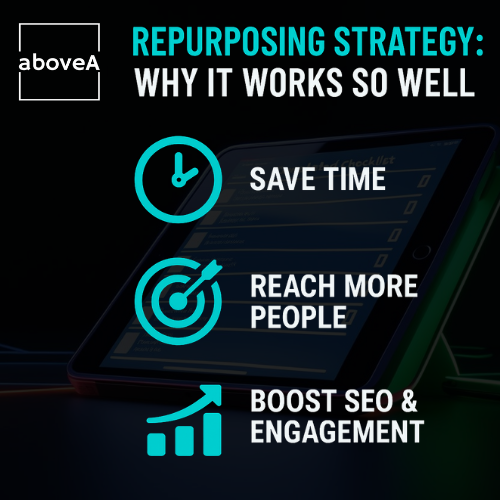
Repurpose Evergreen Content: How to Pick the Right Blog Post
Repurpose evergreen content first if you seek your efforts to go further. Evergreen posts have a tendency to stay useful over time. It can make them ideal for turning into multiple formats. You can think of tutorials, how-to guides, beginner tips, or problem-solving articles: these topics never go out of style!
To find your best candidates, you’d better use tools like Google Search Console or Google Analytics. Then, look for high-performing blog posts with steady traffic, long time-on-page, or lots of backlinks. These signals mean people already trust the content, and repurposing it can expand its reach even more. Plus, you can also reuse blog content that had strong performance in the past but has started to decline. Giving it new life on platforms like LinkedIn, Instagram, or YouTube Shorts can revive interest and bring traffic back.
However, you should avoid time-sensitive or trend-based posts unless you’re updating them first. Outdated content doesn’t repurpose well and may confuse new audiences. Starting with the right blog post makes every step of repurposing easier and far more impactful.
The Repurposing Plan - Turn One Blog Post Into 5 Formats
Let’s say you already chose a strong blog post. Now it’s time to put it to work. In this section, I will show you exactly how to transform that single post into five fresh, high-impact formats: each built for a different audience, platform, and purpose. I will provide you with some proven ways to get your message seen again and again without writing a single new sentence from scratch.
Here’s your step-by-step breakdown.
Format | Where to Share It | Purpose |
LinkedIn Post | LinkedIn, Facebook, Threads | Thought leadership, wider reach |
Short Video | TikTok, Instagram Reels, YouTube Shorts | Visual storytelling, discoverability |
Email Newsletter | Email lists, automation flows | Build trust, increase return visits |
Carousel or Infographic | Instagram, Pinterest, LinkedIn | Shareable, saveable, visual insights |
Audio or Mini Podcast | Spotify, YouTube, blog embeds | Broader content types, accessibility |
1. Repurpose Content for LinkedIn or a Social Post
To repurpose content for LinkedIn, pull the core idea from your blog and turn it into a short, engaging insight. Use a bold hook, a quick takeaway, and make it personal if you can. For example:
“Most blogs get read once and forgotten. Here’s how to turn one post into five high-impact formats. 🧵👇”
Use hashtags that match your audience, and end with a clear CTA like “Agree? Share your take below.”
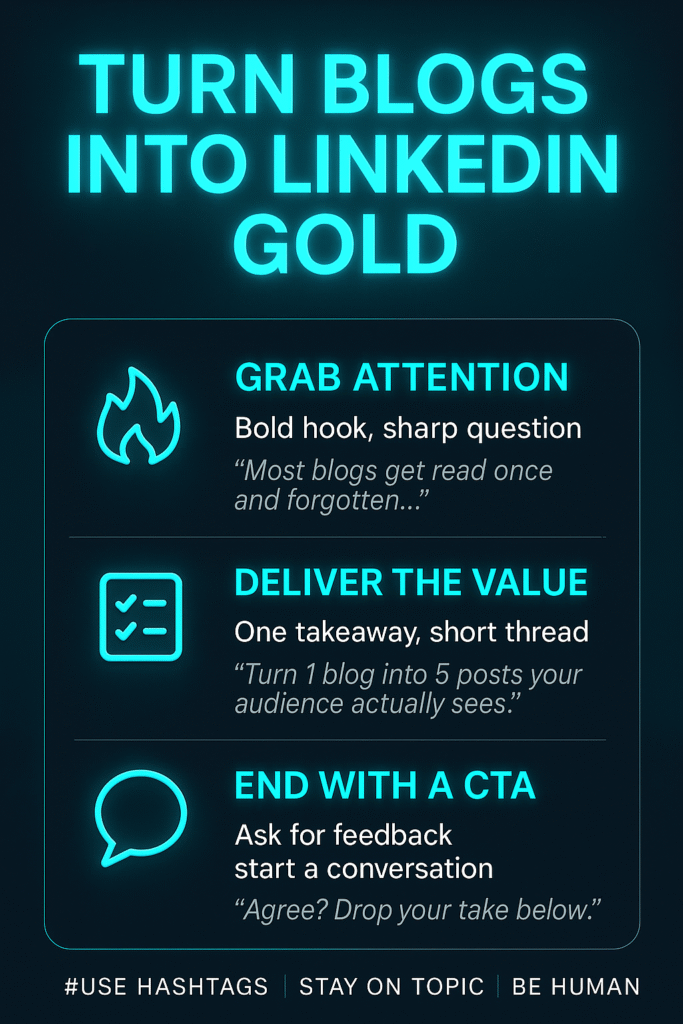
2. Repurposing Content for Short Video or Reel
Turn the blog into a video by scripting out 2-3 key tips from your post. Keep it short (30–60 seconds). Use a face-to-camera format or screen-share if you’re showing tools or steps. Add captions and start strong with a hook like:
“Still writing blog after blog? Let me show you how to turn one post into five smart pieces of content…”
Don’t forget to include a CTA, like “Follow for more content tips.”
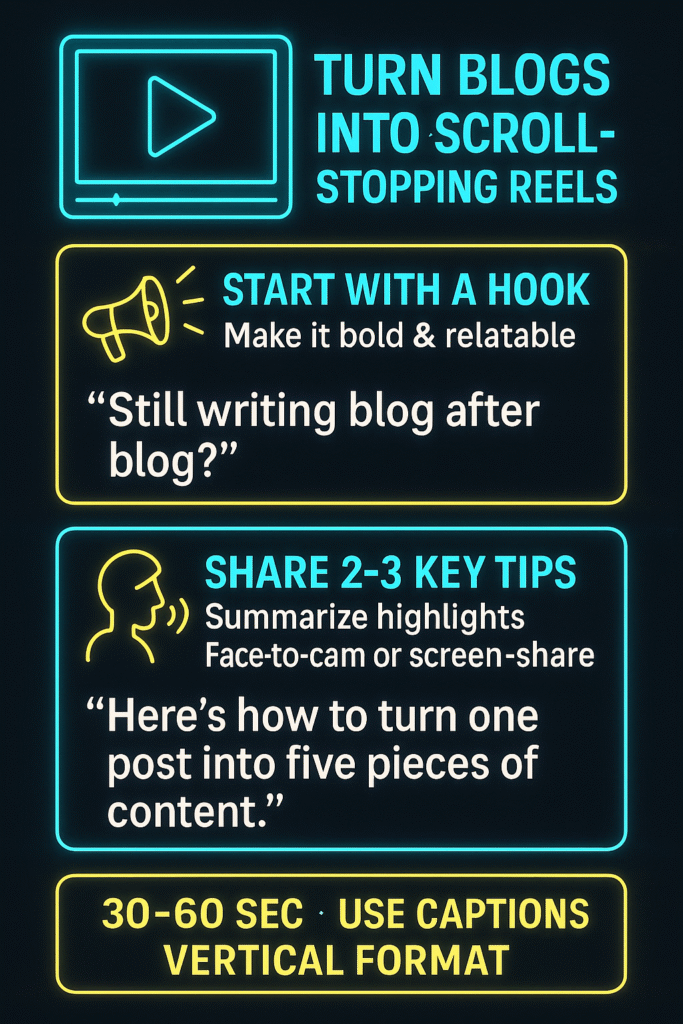
3. Repurposing Content for Newsletter or Email Campaign
Blog to newsletter is a perfect match. Use the intro paragraph of your blog as the email opening. Then add a quick insight, a related tip, or even a free downloadable (like a checklist or template). Link back to the original post or related content.
Subject line example:
“Stop Wasting Blog Posts: 5 Ways to Use Just One”
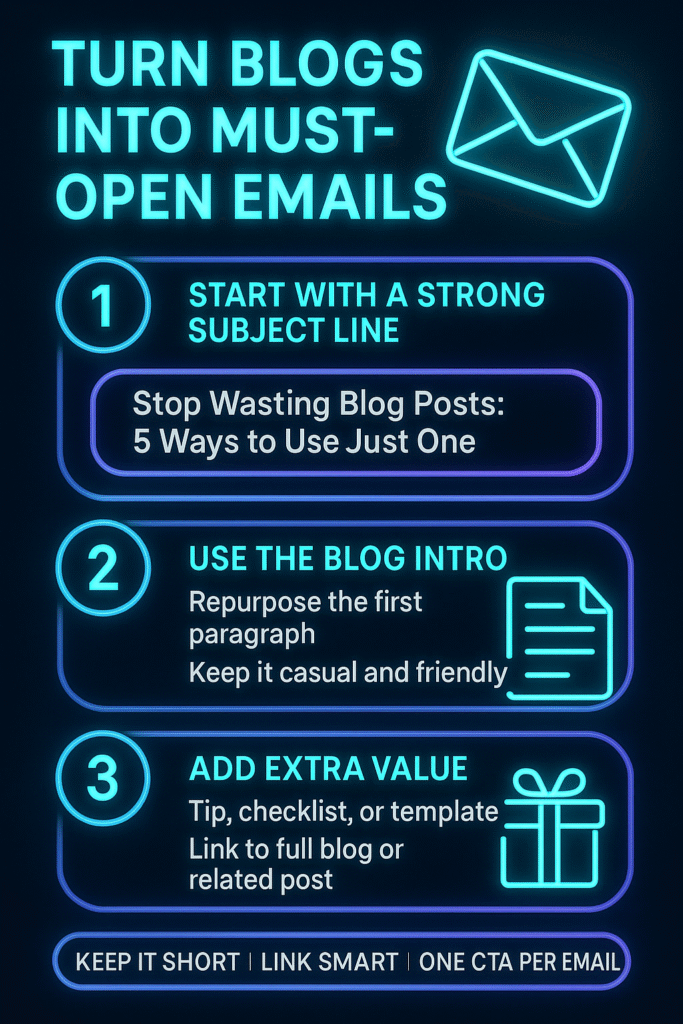
4. Repurposing Content for Infographic or Carousel
Turn your blog’s structure into a carousel or infographic using a tool like Canva. Each header becomes one slide or one graphic section. Keep text short. Use icons, short phrases, and one takeaway per slide. Aim for shareability.
Perfect for Instagram, Pinterest, or even LinkedIn carousels.
Slide 1: “How to Turn 1 Blog Into 5 Powerful Content Pieces”
Slide 2-6: Show each format, tip, and tool.
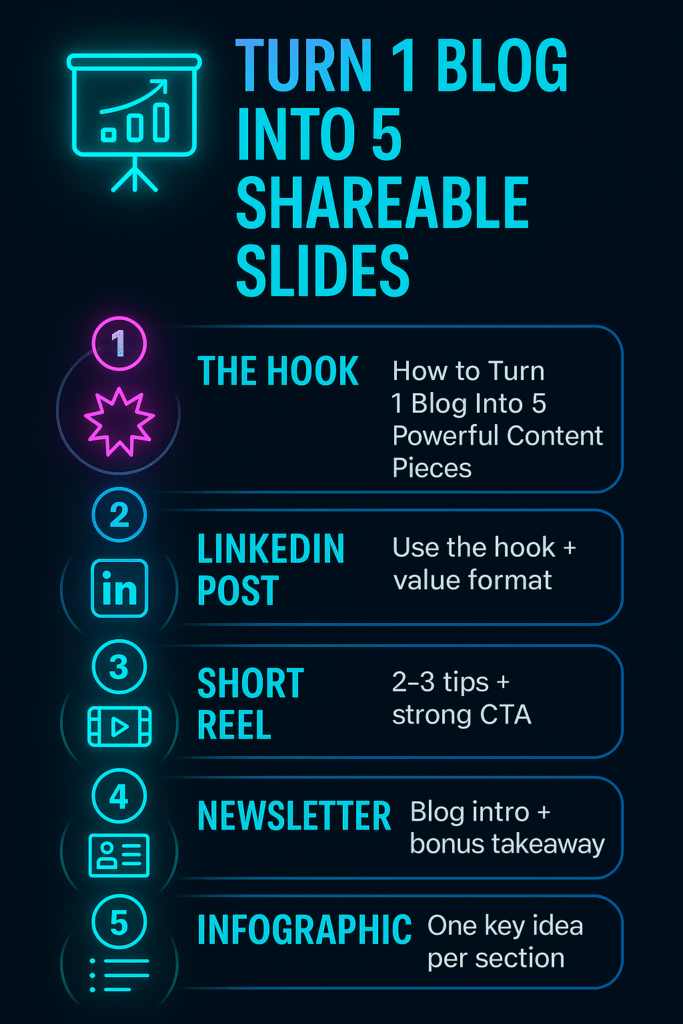
5. Repurposing Content for Audio Clip or Mini Podcast
To turn a blog post into a podcast, record a short voice note where you explain the key points. You can summarize the blog or expand on one idea in a personal tone. Add a quick intro and outro to make it sound polished. Use free tools like Anchor to publish to Spotify.
With this approach, you don’t just create once; you scale content across platforms, formats, and audiences. That’s the magic of repurposing done right.
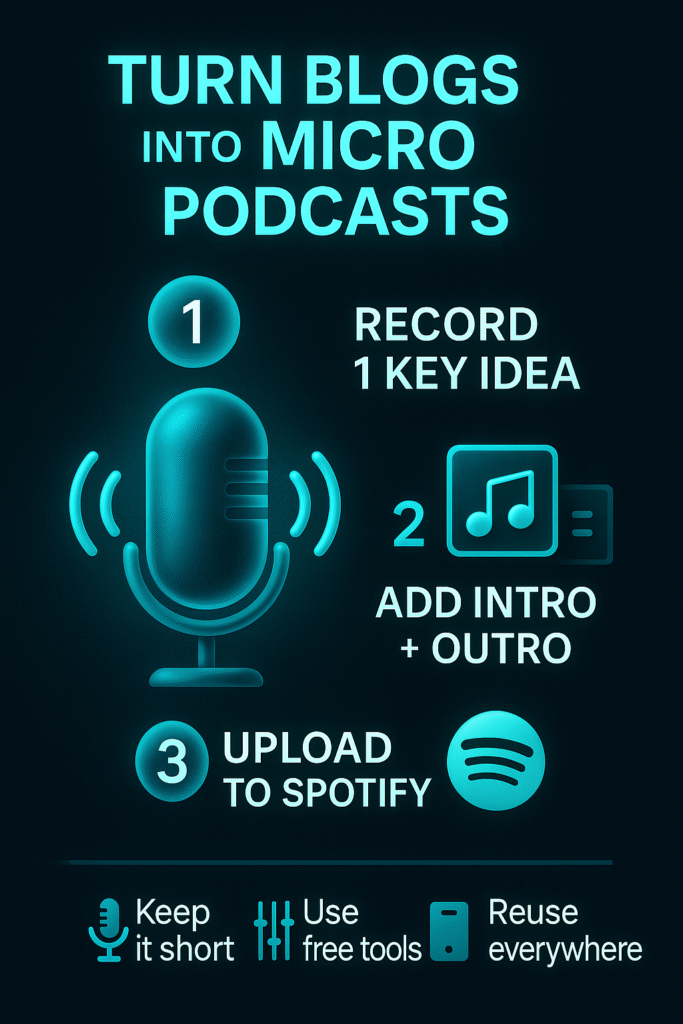
Content Recycling Tools to Help You Work Faster
If you don’t have to do everything by hand, it’s not a problem! There are a lot of good tools out there that you can utilize for content recycling. They are easy to use and, most importantly, affordable.
Canva makes it easy to turn blog content into carousels, infographics, or quote graphics. Use templates, icons, and animations to create visuals, even if you’re not a designer.
Repurpose.io helps you set up automated content workflows. For example, you can publish a video on YouTube and automatically clip parts for TikTok, LinkedIn, or Shorts.
Descript lets you record and edit audio or video. You can also turn blog posts into narrated clips or simple podcasts without complicated software.
ChatGPT and other AI tools can quickly summarize, rewrite, or extract key points from your blog to use across formats.
Finally, Hootsuite or Buffer helps schedule your repurposed content across platforms, so you stay consistent without logging in every day.
Together, these tools make repurposing simple, fast, and scalable.
Common Repurposing Mistakes to Avoid
One of the biggest mistakes is copy-pasting blog content without changing it to fit the format. What works in a blog often feels awkward in a tweet, carousel, or short-form video. Another issue? Not adjusting the tone or length for different platforms. A formal blog tone won’t work on TikTok. And a 300-word email isn’t ideal for Instagram.
You should also avoid skipping CTAs. Every repurposed piece should guide users toward the next step: click, comment, share, or subscribe. And don’t forget about SEO when republishing. Especially if you post to Medium, LinkedIn Articles, or partner sites.
Here’s a quick breakdown of some common repurposing mistakes and what you can do instead:
Mistake | Why It’s a Problem | What to Do Instead |
Copy-pasting formats | Feels off or awkward in new contexts | Adapt tone, style, and structure |
Not adjusting tone/length | Doesn’t match platform expectations | Fit content to audience and platform |
No clear CTA | Missed conversion opportunities | Always include a call to action |
Forgetting SEO | Hurts ranking or causes duplicate content | Rewrite titles, structure, and use canonicals |
Repurposing weak blog posts | Wastes time on low-value content | Start with evergreen or high-performing posts |
Avoiding these mistakes ensures your repurposed content not only reaches more people but also works harder for you.
Turn 1 Blog Into 5x Content!
Don’t let great posts fade. We’ll help you turn them into videos, carousels, emails, and more.
Conclusion: Repurposing Makes Every Blog Post Work Harder
Repurposing isn’t about doing more. It’s about doing smarter. With the right strategy, one blog post can become five (or more) high-performing content pieces, each tailored to a different audience, format, and platform.
In this guide, you learned how to pick the right post, break it into powerful formats, use tools to speed things up, and avoid common mistakes. This approach not only saves time but also boosts visibility, SEO, and engagement across your channels. Stop letting great blog posts fade after one share. Turn each one into a content engine.
Meet the Author

Karina Kavaleuskaya
She combines a passion for storytelling with a strategic mindset to help brands grow, stand out, and connect deeply with their audiences. Through thoughtful, impactful writing, she turns complex ideas into clear, engaging narratives that drive results.

